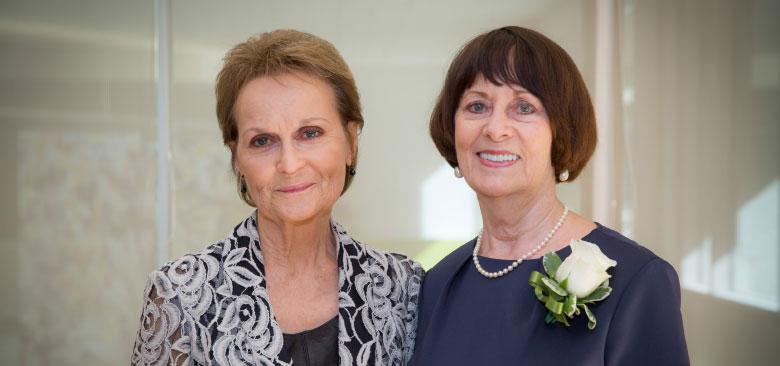
2017 Nahm Lecturer Kathleen Puntillo (right) with Interim Dean Sandra Weiss
Go Where the Research Takes You: Kathleen Puntillo Delivers the 2017 Nahm Lecture
At the start of the 37th Helen Nahm Research Lecture in spring 2017 – titled “Intensive Caring: Palliation of ICU Patient and Family Distress” – the UC San Francisco School of Nursing’s Kathleen Puntillo invited the audience of nurse-researchers, educators and clinicians to ask themselves, “Why should I continue on my own [research] journey?”
For Puntillo, who has spent her career researching pain management and palliative care in the intensive care unit (ICU), the answer lies partly in serendipity. A chance meeting of like minds, a surprising research finding that leads to another question and a new way of thinking about a problem – all these and more have inspired her over a 27-year research career spent reducing suffering among ICU patients and their families.
Palliative Care Can Coexist with Curative Care in the ICU
During the lecture to a packed auditorium, Puntillo outlined the highlights of her research career, which began at a time when there was little research into pain and symptom management in the ICU and clinicians primarily emphasized disease-modifying treatments.
“I learned that, along the way to death or recovery, we can attend to the physical and psychic distresses that ICU patients and their families experience,” Puntillo said. “Not only can palliative care coexist with curative care in an ICU, but [it] can even extend beyond death as bereavement care for patients’ families and friends.”
As her career progressed, she recognized three domains of palliative care relevant to her work: symptom management, communication and family support. Her research program has delved into all three.
Treating Procedural Pain
Puntillo’s first symptom management research project assessed postoperative pain in the ICU’s thoracic and abdominal surgery patients. Employing a set of pain measures not previously used in the ICU, she found that patients had significant postoperative pain, particularly associated with two common procedures: endotracheal tube suctioning and chest tube removal. There were almost no pharmacological interventions for procedural pain.
 “I knew I had my work cut out for me,” Puntillo told the audience.
“I knew I had my work cut out for me,” Puntillo told the audience.
With the support and encouragement of Marylin Dodd, then associate dean for Academic Affairs at the School, Puntillo conducted a randomized, double-blind, placebo-controlled trial of targeted injections of local anesthetic versus normal saline for chest tube removal.
While she and her research team found no significant differences in pain scores between the intervention and placebo groups, “by accident or serendipity” they found that some patients who had received intramuscular injections of the nonsteroidal anti-inflammatory drug (NSAID) ketorolac for general postoperative pain had lower pain scores during chest tube removal.
This finding led Puntillo to conduct another trial comparing the analgesic effects of an IV opioid (morphine) versus an IV anti-inflammatory (ketorolac) during chest tube removal. Her team found little difference between the two approaches when the medication was timed to be at peak effect during the procedure; these results gave clinicians an additional tool for their pain relief arsenal.
Puntillo was also part of two important multiyear studies of procedural pain among ICU patients: the American Association of Critical Care Nurses’ Thunder Project II (named for its potential big impact on patient care) and Europain.
Thunder Project II looked at pain in over 6,000 patients undergoing six common procedures in the ICU. Results were striking: Patient turning was the most painful procedure, and 40 percent of patients with pain prior to the procedure received no opioid pain relief. The research yielded eight research papers, including one that made groundbreaking recommendations for translating their findings into practice.
Puntillo subsequently received an Established Investigator Award from the European Society of Intensive Care Medicine – the first American and first nurse to receive it. The award supported design and implementation of the Europain study, which sought to expand on Thunder Project II’s findings, examining pain intensity and analyzing pain predictors and distress among almost 4,000 patients across 192 ICUs in 28 countries.
As a member of the Society of Critical Care Medicine, Puntillo also helped put findings from these and other large studies into practice with a set of 2013 clinical practice guidelines for addressing ICU-related pain. The guidelines included providing pre-emptive analgesia and using nonpharmacological interventions prior to potentially painful procedures like chest tube removal.
Recognizing Pain in the Most Vulnerable Patients
Back at UCSF, Puntillo revisited a question that had troubled her since working on her doctoral dissertation: What can we do for patients who can’t self-report pain or distress? This is particularly relevant in the ICU, where many patients are unable to tell clinicians when they’re suffering. The reasons range from being intubated to having illness- or injury-related communication deficits.
To address the issue, Puntillo gathered a research team that developed an algorithm to help nurses recognize behavioral and physiological indicators of pain and rate their intensity. Working first with patients who could self-report, they validated several behaviors, such as grimacing, wincing and vocalization, that could be used to identify pain in patients unable to self-report. The study gave clinicians a reliable set of behaviors to watch for to determine when their most vulnerable patients need more help managing pain.
Pain Isn’t the Only Symptom
Puntillo and her team also recognized that pain wasn’t the only distressing symptom ICU patients experience. In a National Institute of Nursing Research (NINR)-funded study, they found that the most prevalent symptom was fatigue, followed by thirst, which was the most intense of the 10 symptoms they studied.
“Realizing that you go where the research findings take you, I wondered what we could do about patient thirst,” Puntillo said.
Her research team tested a “bundle” of interventions – including ice-water mouth sprays and swabs, and application of a menthol moisturizer to the lips and mouth – in a National Institutes of Health (NIH)-funded study. Patients who received the bundle had a statistically significant decrease in thirst scores compared with those who received usual care.
An Edward A. Dickson Emeritus Professorship Award then allowed Puntillo to develop a quality improvement project to teach ICU nurses to provide the thirst intervention, which resulted in significant decreases in patient thirst – without burdening nurses.
Reducing Distress for ICU Families
Patients aren’t the only ones who suffer and experience distressing symptoms, Puntillo told the audience. She noted that her PhD degree student Jennifer McAdam, now an assistant professor of nursing at Samuel Merritt University, has found that many family members of ICU patients report a variety of symptoms, including fatigue, depression, traumatic stress, decreased appetite and a lower sense of well-being.
This led to a new research path. With Judith Nelson (currently chief of Memorial Sloan Kettering Cancer Center’s palliative care service), Puntillo conducted a study of ICU patients and families and catalogued their experiences. She related the words of one of the subjects, whose mother had just died in ICU:
“At 8:00 PM, I went out there and felt like I was going into a war zone. I was put out like, out on the street. No one told me anything. They knew several days beforehand that I had arranged the date [for ventilator withdrawal], but nobody approached me.… Nobody asked, ‘Are you able to take care of yourself; are you able to find a place to go to, as far as for grief, for death of your mother?’”
Working with patients and families, Nelson and Puntillo developed a definition of high-quality intensive care shared by patients and clinicians that included timely and compassionate communication; clinical decision making that focused on patients’ preferences, goals and values; and support and bereavement care for families.
Improving Communication in the ICU
Patient and family stories from that study prompted Puntillo to think about what she called the second domain of palliative care: communication.
She and Nelson conducted communication workshops in New York Veterans Affairs hospitals, which led to the development of UCSF’s IMPACT-ICU: Integrating Multidisciplinary Palliative Care into the ICU project, led by Associate Professor of Medicine Wendy Anderson. In the project, they and their team conducted role-playing workshops to help ICU nurses at UCSF and four other UC hospitals improve communication skills.
With a former PhD degree student, Commander Virginia Blackman, Puntillo is also bringing the IMPACT-ICU project to Walter Reed National Military Medical Center, where they are training nurses, social workers, clinical psychologists and chaplains to conduct communication workshops for ICU nurses.
Supporting Families Who Play Many Roles
The challenge of communicating effectively with families, said Puntillo, led her to focus on family support, the third domain of palliative care.
Family members play many roles in the ICU, including advocate, defender, historian and caregiver, and Puntillo has come to understand the importance of fostering and facilitating family engagement. She noted specific measures, like family diaries, having families do the thirst intervention, and liberalizing visitation policies, as things that can be done to increase and improve engagement.
The Importance of Being There
Puntillo took note of the circuitous route of her research career, but in the end, she said, it led her to where she believes she needed to go.
In closing, she inspired the entire audience with this reflection: “I can’t overemphasize the importance that ‘being there’ played in my career. Being there in the ICU where the patients are, whose lives you hope to make better and whose distress you want to palliate. Being there, where other colleagues are working together in teams to improve the care of vulnerable ICU patients and their families. I had to be there. I loved being there.”



